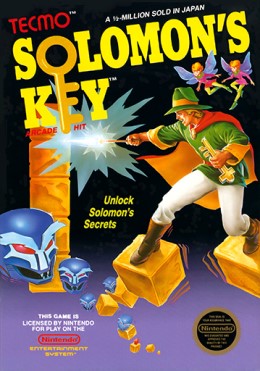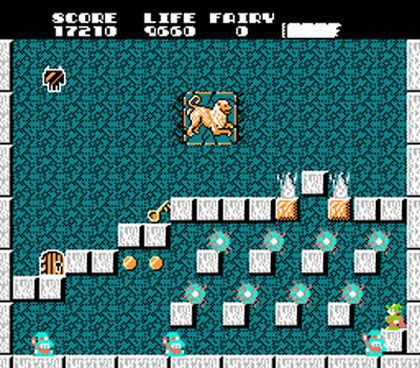While browsing through some classic NES games on the ol' emulator, I came across Solomon's Key. I enjoyed it back in the day, never beat it, had some time on my hands, so I thought I'd give it a run through.

Solomon's Key is a puzzle/platformer game released by Tecmo in 1987.
Taken from Wikipedia:
"The main character, named Dana, is sent to retrieve "Solomon's Key" to restore the world to light from demons that were accidentally released. The object of the game is to advance through the 50 rooms of "Constellation Space" by acquiring a key to the door that leads to the next room before a timer runs out. The game incorporates elements of the platform shooter genre. Dana can run, jump, create or destroy orange blocks adjacent to him as well as create fireballs to destroy demons. The orange blocks can also be destroyed by hitting them with your head twice. Along the way Dana can acquire items to upgrade his firepower and extra lives as well as items that award bonus points and unlock hidden rooms. With certain items, Dana must make, then break blocks (sometimes in a certain manner) to make these appear."

Title Screen
The difficulty of Solomon's Key falls into the Nintendo Hard category. While the controls and mechanics feel solid for such an old game, it's very stingey with 1ups and offers no save or password feature. The game does offer the opportunity to continue (by pressing up+a+b at the game over screen), but only at the first level of the current group you're on (levels are grouped 1-4. 5-8, 9-12, etc.) with only 2 extra lives each time.
The lack of a save/password feature really hurts this game. With 49 default levels (a handful of which are extremely difficult) and 15 secret levels, an average newbie would have to begin playing the game from sunrise in order to finish the game without leaving the NES on overnight to continue the next day. Get frustrated with the game halfway through and decide to turn it off or play something else, and be prepared to start all over again from the beginning next time around.

Thankfully, the emulator I was using has extra features that work around these restrictions. While I didn't want to completely spoil the game by going all Gameshark on it with invincibility or unlimited fireballs, I did utilize saved states to save my progress after each level, which basically equates to having unlimited lives.
While that may seem like a huge advantage, I still had to solve each puzzle using trial and error the way they were intended. Some rooms were particularly frustrating, and I still died numerous times on the few rooms in which I resorted to a Youtube walkthrough to solve (43, 46, 49). I also stayed true to the game by beating it in one sitting.
That corridor section in the middle of the room is the epitome of Nintendo Hard.
Despite the save-state advantage and walkthroughs, it still took over 7 hours for me to complete and receive the weakest of 3 possible endings.
What I liked:
Controls and mechanics are tight for a game from that era.
Simple design that leads to complex situations.
That it's Nintendo Hard.
What I didn't like:
Level 43 alone would've taken me hours to figure out without a walkthrough.
The mechanic of needing to hit a specific area/block with your wand before it's able to destroy certain necessary blocks in a few levels is not self-evident, misleading and cruel.
That it's Nintendo Hard.
Comments (1)


No comments:
Post a Comment